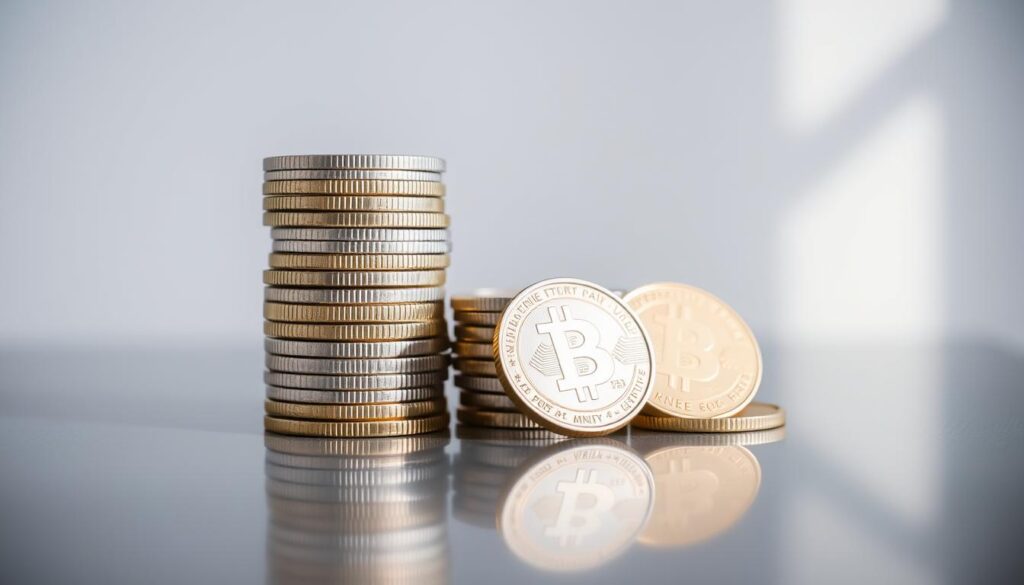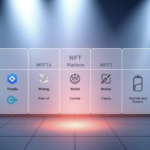Now Reading: Optimize Your Crypto Mining: Discover the Best Practices
- 01
Optimize Your Crypto Mining: Discover the Best Practices
Optimize Your Crypto Mining: Discover the Best Practices
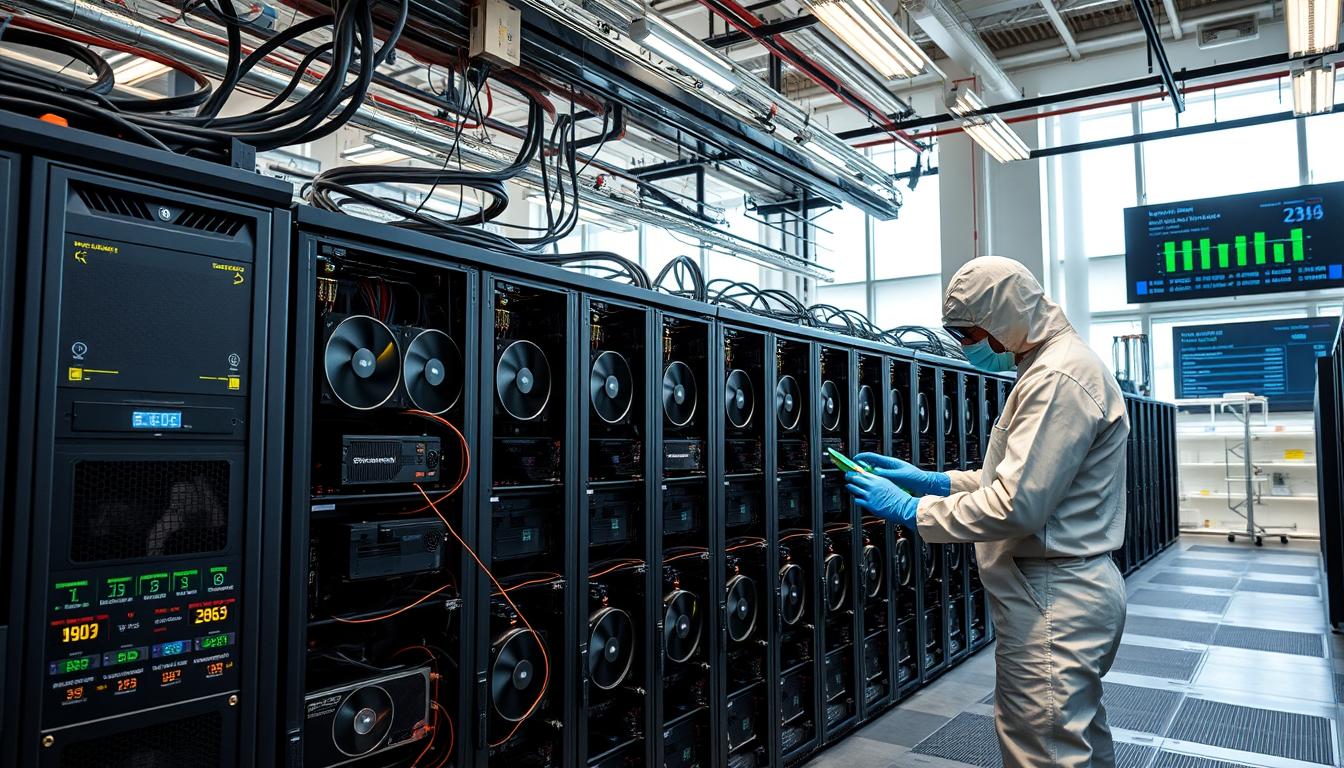
Getting into cryptocurrency mining is more than just setting up your gear. This guide shows you the top ways to make more money in 2023. You’ll learn how to pick the best equipment, use software wisely, and cut costs. These tips are for everyone, no matter your experience level.
Key Takeaways
- Start with clear goals to align hardware and software choices.
- Monitor energy costs to improve profitability using efficient crypto mining techniques.
- Research coin difficulty and market trends before investing in hardware.
- Use mining software updates and cooling solutions to extend hardware lifespan.
- Adapt strategies to regulatory changes and price fluctuations.
Understanding the Fundamentals of Cryptocurrency Mining
Before we dive into tips and strategies for mining, let’s understand the basics. Blockchain mining is key for cryptocurrencies like Bitcoin and Ethereum. It verifies transactions and adds them to a shared ledger.
How Blockchain Mining Works
Miners compete to solve complex puzzles with powerful tools. When they solve one, they add a block to the chain. This earns them new coins and keeps the network safe from fraud.
Proof of Work vs. Proof of Stake
- Proof of Work (PoW): Needs lots of energy for computations. Bitcoin uses PoW, where miners race to validate transactions.
- Proof of Stake (PoS): Chooses validators based on how many coins they hold. Ethereum moved to PoS, cutting energy use while keeping it secure.
The Economics Behind Mining Operations
Profit comes from block rewards and transaction fees. Over time, block rewards, like Bitcoin’s “halving” events, decrease. Miners must adapt. Difficulty adjustments keep mining competitive, balancing profit with costs.
Knowing these basics helps miners pick the right cryptocurrencies and gear. Stay updated to keep up with changing protocols and market trends.
Evaluating Your Mining Goals Before Starting
Before you start mining crypto, know what you want to achieve. Whether it’s for fun or to make money full-time, best crypto mining practices mean matching your goals with your resources. First, think about your budget, technical skills, and how much time you can dedicate.
Do a cost-benefit analysis first. Note down all costs like hardware, electricity, and software fees (see top mining software options). Use online tools to estimate your earnings. Think about three main things:
- Investment capacity: Entry-level setups vs. high-end rigs
- Risk tolerance: Volatile crypto prices vs. stable income streams
- Scalability: Options to expand operations over time
Being honest about your situation is key. Hobbyists might choose cheaper GPUs, while pros go for ASIC miners. Also, consider your location’s electricity costs—places with under 10 cents/kWh are more profitable.
Ignoring this step can lead to wasting resources. Many newbies overlook software tools or don’t check pool fees, which can cut profits. Setting clear goals helps avoid disappointment later.
Best Crypto Mining Practices for Beginners and Experts
Mastering best crypto mining practices is about finding the right balance. It’s not just about how big you start, but also how you plan to grow. The image below shows important metrics miners check every day to get better. 
Setting Realistic Expectations
New miners often underestimate the learning process. Begin with affordable GPUs like AMD RX 580 cards. Then, move to more advanced NVIDIA RTX 4000 series hardware later. Join online forums like BitcoinTalk or Reddit’s mining communities for help. Keep an eye on your daily hashrate to know if you’re on track.
Building a Sustainable Mining Operation
- Set aside time each week for hardware maintenance to avoid overheating
- Use platforms like NiceHash to mine different coins and reduce risk
- Get backup power solutions to keep mining without interruptions
Adapting to Market Changes
Watch for weekly changes in blockchain difficulty with Blockchair analytics. Switch between mining Ethereum Classic and Monero based on network changes. Use auto-switching software like BFGMiner to improving mining profitability when the market is unpredictable. Keep up with news about ASIC releases that might change the mining game for certain coins.
Selecting the Right Cryptocurrency to Mine
Choosing the right cryptocurrency to mine involves looking at several factors. The top crypto mining strategies focus on coins with stable rewards and growth. Start by checking which assets give the best returns based on your hardware and energy costs.
Profitability Analysis of Different Coins
Use profitability calculators to compare coins like Bitcoin, Ethereum, and new altcoins. Look at block rewards, electricity costs, and network hashrate. For instance, Litecoin might offer better returns for smaller setups because of its lower hashrate.
Always check live data to avoid using old information.
Difficulty Levels and Network Hashrates
- Watch a coin’s network hashrate trends—rising difficulty can lower rewards over time.
- Coins with predictable halving schedules, like Bitcoin’s biannual reward drops, need long-term planning.
- Lower-difficulty altcoins might boost short-term gains but carry higher price volatility risks.
Long-term Potential vs. Short-term Gains
Established coins like Bitcoin provide steady returns but need big hashrate investments. Newer projects might offer maximizing mining rewards through lower competition. But, their market stability is uncertain.
Diversify your mining portfolio: put 60% resources in proven assets and 40% in high-potential altcoins.
Essential Hardware Considerations for Optimal Mining
Choosing the right mining hardware recommendations is key to success. GPUs from NVIDIA and AMD are great for Ethash algorithms. Meanwhile, ASICs are best for Bitcoin mining. For instance, NVIDIA’s RTX 4080 series is excellent for Ethereum. Bitmain’s Antminer S19 Pro is top-notch for SHA-256 coins.
- GPUs: Look for models with high VRAM (8GB+) for modern algorithms.
- ASICs: Opt for specific models for coins like Bitcoin or Litecoin.
- CPUs: They’re only good for low-complexity coins; not for mainstream ones.
To optimize mining performance, you need a balanced system. Use high-end GPUs with power supplies that can handle 100% load. Make sure your motherboard has enough PCIe slots and cooling, like liquid cooling, for dense setups. Modern algorithms need lots of VRAM—16GB is best for Ethash variants to avoid slowdowns.
When buying, consider new vs. refurbished hardware. New gear comes with warranties but costs more. Refurbished gear can save 30-50% but needs authenticity checks. Check ASICs with manufacturer serial numbers to avoid fakes. Compare hash rates, power draw, and durability to calculate ROI.
High-end GPUs like AMD’s RX 7900 XT or NVIDIA’s 4090 offer high hash rates but need strong cooling. Mid-tier GPUs can still make money for less competitive coins. Always match your hardware with your target cryptocurrency’s algorithm and market trends.
Maximizing GPU Performance for Efficient Mining
Modern GPUs like the NVIDIA RTX 4090 or AMD Radeon RX 7900 XT have hidden potential. To unlock it, you need to fine-tune clocks, voltages, and cooling. These efficient crypto mining techniques help keep hash rates high without harming your hardware. Adjusting settings right can increase output by 15-20%, but be careful not to overheat.
Overclocking Strategies and Risks
Begin by increasing core clocks by 20-50 MHz with tools like MSI Afterburner. Lower memory timings (CL16 to CL14) to reduce latency. Keep power limits below 85% of the rated TDP. But, beware of overheating, which can slow down your GPU.
An RTX 4080 can see a 10% boost in Ethereum hashrate with 220 MHz core boosts at 240W power limits.
- Test stability with ethminer stress tests for 24-hour runs.
- Use reference cards like the RTX 3080 Ti for comparison baselines.
- Avoid voltage overshoots exceeding 1.25V to prevent VRM damage.
Cooling Solutions to Prevent Thermal Throttling
Active cooling systems keep your GPU at the right temperature all day. Custom water loops can drop ambient temps by 15°C. Thermal pads on VRMs and VRAM chips help with heat dissipation.
Immersion cooling in mineral oil baths keeps temps below 75°C without fan noise. Fan curves should start ramping up at 65°C to avoid sudden spikes.
- Install case fans for airflow in multi-GPU setups.
- Use thermal paste with 0.1mm application thickness for optimal conductivity.
- Monitor temps via MSI Afterburner or MSI Dragon Center.
Driver Optimization Techniques
Old drivers can cut GPU performance by up to 10%. NVIDIA users should enable NVIDIA Control Panel power profiles. AMD’s Radeon Software lets you set custom fan curves.
BIOS flash tools like GPU-Z reveal hidden voltage limits. Regular driver updates, like NVIDIA 536, fix mining bugs. Tools like MSI Afterburner make real-time adjustments easy.
Power Consumption Management and Electricity Costs
Electricity costs can quickly erode crypto mining profits. To improve mining profitability, focus on efficient crypto mining techniques that reduce energy waste. Start by calculating your rig’s watts per megahash—divide total power consumption by hash rate—to gauge efficiency.
Compare your results to benchmarks like Bitcoin’s 50–100 W/MH or Ethereum’s 10–20 W/MH. This helps identify areas for improvement.
Optimize runtime with these strategies:
- Use smart plugs (e.g., TP-Link Kasa) to schedule mining during off-peak hours when rates drop 30–50%.
- Configure mining software to pause operations when electricity prices spike via APIs like CoinWarz.
- Replace outdated ASICs with energy-efficient models like Bitmain Antminer S19 XP for up to 30% lower power usage.
Geographic flexibility unlocks further savings. Miners in Texas save 20–40% by relocating to areas with renewable energy grids, such as Iceland’s 100% geothermal/hydroelectric power. Solar setups with Tesla Powerwall backups provide stable 6–8 cents/kWh rates, as seen in Arizona’s solar farms.
Pair these approaches with real-time monitoring tools like NiceHash Manager’s profitability tracker. This allows for instant adjustments.
Every watt saved compounds into long-term gains. Prioritizing energy efficiency today builds a sustainable path to maximizing net revenue.
Selecting and Optimizing Mining Software
Choosing the right software is key to successful crypto mining. Apps like T-Rex, GMiner, and NBMiner cater to various algorithms. Each has its own set of features, fees, and community support. It’s important to pick one that fits your hardware and mining goals.
For efficient crypto mining techniques, tweaking settings is crucial. This includes adjusting fan curves, power limits, and algorithm-specific parameters. Overclocking GPUs or adjusting ASIC voltages can boost efficiency but must be done carefully to avoid damage.
Tools like HiveOS and Minerstat help monitor performance. They track hash rates, temperatures, and profitability in real-time. These tools also alert you to issues like overheating or software crashes, helping to minimize downtime.
Security is also a top priority. Always check software downloads with checksums to avoid malware. Stay away from unofficial forks or untrusted sources to protect your hardware and wallets. Keeping your mining software up to date ensures it works with the latest protocols and network changes.
Creating a Secure Mining Environment
Security flaws can ruin even the most profitable mining setups. These cryptocurrency mining tips help keep your hardware, data, and earnings safe. Begin by isolating mining rigs on separate networks with VLANs to block unauthorized access. Also, enable two-factor authentication on all wallets and pool accounts—it blocks 90% of common breaches.
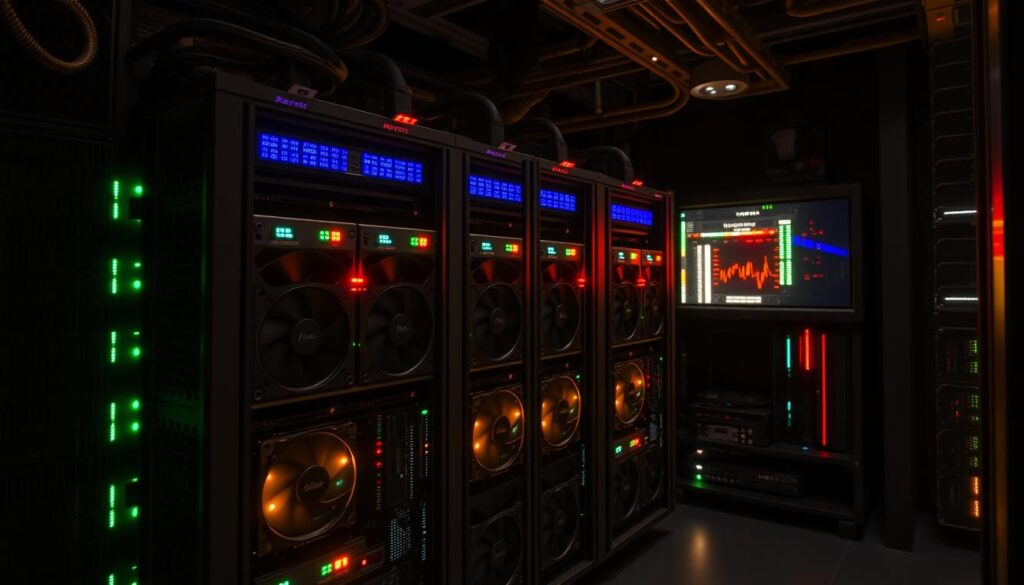
- Software safeguards: Use encrypted wallets like Ledger or Trezor for storing rewards. Never leave hot wallets connected to the internet indefinitely.
- Network encryption: Configure SSH with public-key authentication and disable password logins. Use WireGuard or OpenVPN for secure pool connections.
- Physical protection: Install motion-activated cameras and biometric locks for server rooms. Grounded racks prevent static damage while deterring tampering.
Regularly check firewall rules and update firmware on mining devices. Schedule monthly backups of config files using encrypted cloud storage like Backblaze. The best crypto mining practices also include watching for unusual hash rate drops—a sign of malware. For big operations, hire third-party penetration testers to find vulnerabilities. A single compromised device can cost more than hardware upgrades—focus on defense at every stage.
Mining Pools vs. Solo Mining: Strategic Approaches
Choosing between mining pools and solo mining affects your earnings and strategy. Top strategies balance steady rewards with big potential gains. This section helps you pick the best approach.
When picking a mining pool, look for ones with fast servers near you. Check their uptime—top pools like Slush Pool or F2Pool have 99%+ uptime. Also, choose pools with no minimum payout and clear fees, usually 1–5% of what you earn.
How Payout Systems Work
- PPS (Pay Per Share): Pays right away for each share, great for cautious miners.
- PPLNS (Pay Per Last N Shares): Pays based on recent shares, offering a balance between risk and reward.
- Solo Mining Payouts: Gets you the whole block reward with no fees, but depends on network difficulty.
When Solo Mining Wins
Cryptocurrencies like Monero or Vertcoin adjust difficulty, making solo mining good for small setups. These coins adjust difficulty when hash rates are low, giving solo miners a chance at block rewards without expensive gear. To maximize rewards, keep an eye on network activity and difficulty changes.
Being flexible is key. Watch network difficulty trends—if solo mining looks better, switch. Pools are best for steady earnings on coins like Bitcoin. Solo mining is better when network conditions favor smaller operations.
Tax Implications and Regulatory Compliance for US Miners
For US crypto miners, knowing about tax rules is key to crypto mining best practices. The IRS sees mined cryptocurrency as taxable income right when you get it. You must report rewards as income, and there are capital gains taxes when you sell or trade coins. Not following these rules can lead to legal and financial trouble.
- Tracking all mined and sold coins using accounting software
- Documenting hardware purchases, electricity costs, and maintenance expenses for deductions
- Reporting gains/losses on IRS Form 8949
- Calculating equipment depreciation over 5-year periods
State laws on crypto mining differ a lot. Texas and Wyoming have no sales tax on crypto, but New York has strict rules. Commercial miners should think about how they set up their business. LLCs offer protection but mean you have to file every year.
Following best crypto mining practices means keeping up with IRS and state laws. It’s smart to talk to tax experts to make sure you’re following the rules. Keeping good records helps with audits and lowers legal risks. This is a big part of being successful in the long run.
Scaling Your Mining Operation: From Hobby to Business
To turn a mining hobby into a business, you need a solid plan. First, check if your setup can handle more power and cooling. You’ll need better electrical systems and cooling to keep everything running smoothly.
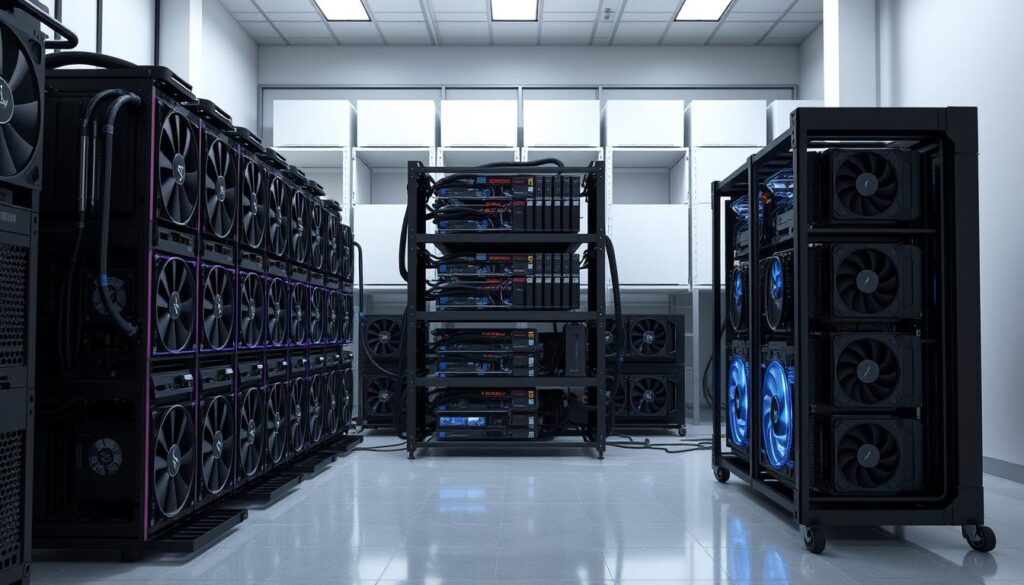
- Electrical audits to handle increased power demands
- Fire suppression systems compliant with commercial standards
- Automated monitoring tools for real-time equipment tracking
When planning your business, think about money matters. You’ll need to get loans or find investors. Also, look for deals on mining hardware recommendations from suppliers.
Choose places like Texas or Washington for low energy costs. These places can help make your mining more profitable. You’ll also need to hire people who know how to keep your mining gear running.
Thinking about renting space for your mining? Look at uptime, power costs, and contract terms. Make sure you understand the service level agreements and how to get out of the contract if needed. Decide if hosting yourself or renting space is better for your business.
Keep your mining gear in top shape with regular checks and smart tools. Update your software often to get the best performance. Growing your mining operation means managing risks well. With the right plan, your hobby can become a steady income source.
Future-Proofing Your Mining Strategy in a Dynamic Crypto Landscape
Staying ahead in crypto mining means always adapting to new tech and market changes. Miners should focus on maximizing mining rewards by keeping up with tech like Proof of Work (PoW) to energy-saving models. For example, Ethereum’s move to Proof of Stake cut energy use but opened new chances in layer-2 networks.
Watching for updates like Bitcoin’s Taproot upgrades is key. This ensures miners are ready for changes that can boost profits.
Hardware innovation is crucial. Companies like Bitmain and MicroBT often release new ASIC models that are more efficient. Planning when to upgrade based on these releases keeps miners competitive and improves mining profitability. Investing in modular setups makes it easy to add new tech without replacing entire rigs.
Energy strategies are also vital as rules get stricter. Using solar or hydroelectric power cuts costs and fits with U.S. efficiency goals. Miners in places like Texas, with cheap renewables, have a long-term edge over those on old grids.
Keeping up with developer forums, GitHub, and events like Consensus 2024 is essential. Diversifying into hybrid setups, mixing old coins with new ones, helps against volatility. Regularly checking software and pool partnerships keeps strategies sharp in a market where leaders change.
Successful miners balance being tech-savvy with being financially smart. Tracking things like hash rate, electricity costs, and rule changes turns reactive plans into proactive ones. The future goes to those who use the latest tech, make smart energy choices, and adapt to market needs.
FAQ
What are the best crypto mining practices for beginners?
Beginners should start by learning the basics of cryptocurrency mining. Start small and grow your operation gradually. It’s important to pick the right hardware and use efficient mining software.
Joining mining communities for support is also key. Remember to set realistic profit goals and do cost-benefit analyses.
How can I maximize my mining rewards?
To get the most from mining, choose the right cryptocurrency. Look at profitability, difficulty, and network hashrates. Using efficient mining techniques like optimizing power and cool hardware setups can boost performance.
Diversifying your mining portfolio can also help manage risks and increase profits.
What hardware is recommended for efficient mining?
For top mining performance, use high-quality GPUs like the NVIDIA GeForce RTX 3080. Specialized ASIC miners, such as Bitmain’s Antminer S19 Pro, are also recommended. Invest in durable power supplies and effective cooling systems.
Choose motherboards that support multiple miners without slowing them down.
What are some effective strategies for power consumption management?
To cut down on power use, mine during off-peak hours. Use smart plugs and invest in energy-efficient hardware. Analyze your operation’s efficiency in watts per megahash to find areas for improvement.
Consider using renewable energy like solar or wind power to lower electricity costs.
How important is mining software optimization for profitability?
Optimizing mining software is key for better efficiency and stability. Learn about popular mining apps and tweak settings for better performance. Using monitoring tools helps catch issues early and keeps performance steady.
Should I mine solo or join a mining pool?
Whether to mine solo or join a pool depends on your hash rate and risk tolerance. Pools offer steady payouts, while solo mining can be rewarding for those with high hash rates. Consider pool fees, payout methods, and your mining goals.
What tax implications should miners in the US consider?
In the US, mining rewards are taxed as income by the IRS. Keep detailed records of income and expenses. Consider capital gains when selling mined coins. A tax professional can help with complex mining tax rules.
How can I future-proof my mining strategy?
To keep your mining strategy up-to-date, stay informed on new trends like alternative mining mechanisms. Invest in versatile hardware and stay flexible. Regularly review your strategies against market and regulatory changes to stay sustainable.


